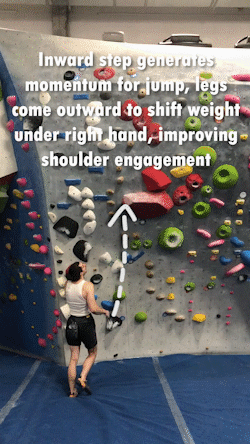Breakdown
Climber: Eddie Pandolfino 6’0”/-2
Wall Angle: 10° Overhang > Flat
Holds: Decoy Limestone Fraguel Pockets, eGrips Hueco Wonder Pockets, Kingdom Climbing Rok Blok
RIC: Risk 1, Intensity 5, Complexity 1
The initial objective of this boulder was to merge Intensity and Complexity. However, during forerunning, the sequence changed to favor intensity. This is emphasized via the campus sequence in the beginning and complimented with a finger strength test with the pockets in the second half. Risk and complexity both rank low on this boulder. Positioning is determined by overall strength and there is little sequence nuance or variation.
Influence/Aesthetic:
There are three different sets of holds on this boulder from three different companies. While it can be difficult to pair holds from different manufacturers, I decided to tie them together through the “rock” texture. There is a visual and functional constriction created by the close proximity of the holds with the large feature acting as the centerpiece. Additionally, there are no footholds, and tracking is used to give climbers a definitive sequence. Removing excess helps create clarity.
Hold Selection:
Pockets were selected to prevent matching and encourage a simple, singular sequence. Although pockets are usually avoided in commercial setting because of high injury potential, this set is particularly ergonomic and still small enough to only be used with one hand. The objective for the block feature was to have it utilized in multiple ways. The climber is able to traverse through it with their hands and use it as a high-profile foot later, which makes the high pockets more positive.
Look Ma’ No Feet
The climber begins by placing their left hand on the start hold closer to the ground. They start a short distance from the wall so they can take two steps and generate momentum for the jump.
After establishing their right hand, the climber moves their legs slightly outward. This brings their weight directly under their right hand, improving shoulder stability.
Stabilizing allows the climber’s left hand to release from the start and match.
The climber’s left-hand needs to swap with the right onto the jibbed part of the hold. A slightly dynamic upward pull quickly lessens weight from the hands, letting them swap places.
Swinging their legs leftward in conjunction with shifting the torso right allows the right hand to move to the next pocket.
High Heels
The climber transitions to having hands in both pockets. This creates enough space for the lower body to begin shifting upward via a right heel.
Gaining the first pocket shifts the climber’s left hip and shoulder slightly higher. This opens the hips just enough to swap to a left toe with the knee pointed slightly inward.
Pulling over the toe allows the climber to fully lock off their right arm and bump to the second pocket.
Tic-Tac-Track
The climber back flags their right foot and turns their knee farther inward to align their weight under their left hand.
Weighting the left hand fully lets the climber’s right-hand track into the first pocket.
Moving the left hand to the third pocket straightens the climber’s torso. This allows the left knee to rotate farther right, shifting weight across the climber’s midline to the left.
The new leftward alignment of weight lets the climber bring their right foot up to swap feet.
Taking the Top
The climber swings their left leg upward in conjunction with their left arm extending to gain the finish.
Their right foot is moved slightly higher to center the hips underneath the left hand to match.
Final Thoughts
This boulder was a failed experiment. I tried to recreate an easier version of a foot-first sequence I set a few weeks back but it became clear during forerunning that the intention was not going to work; the campus sequence was much easier than any other considerable beta. Abandoning an idea can be frustrating and defeating after putting effort into finding a solution but failure is the most important part of growth. If you are not pushing the boundaries, the realm of possibility for movement never expands. New possibilities can lead to missteps, but learning opportunities outweigh the risks and failures enlighten more than successes.




